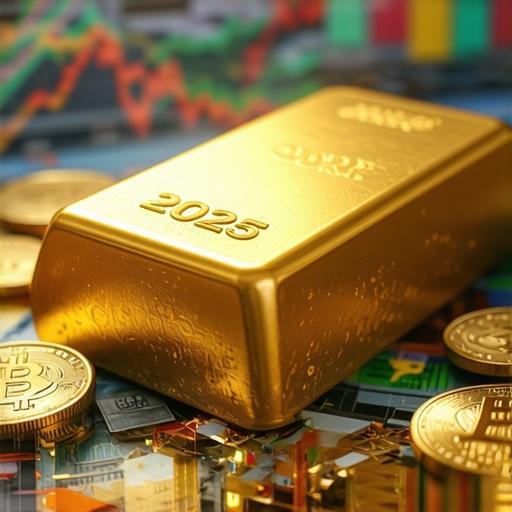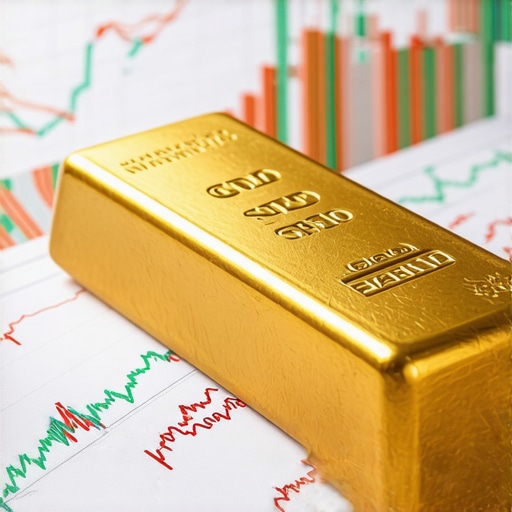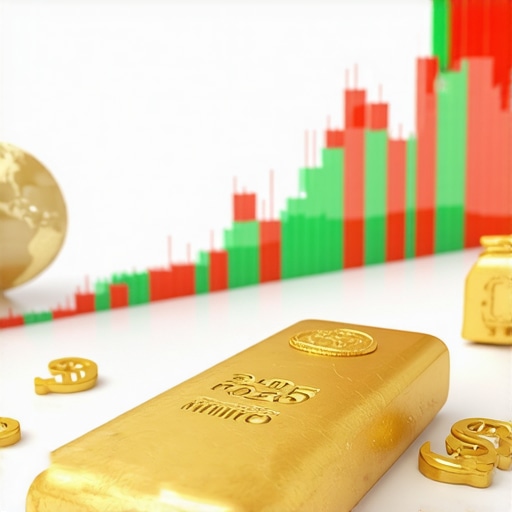Gold’s Glittering Tale: Why Demand Trends Make the Price Dance
Picture this: a glint of gold catching the eye in a bustling market, its value whispering secrets of global economies, investor moods, and geopolitical tremors. Understanding gold demand trends isn’t just for the Wall Street crowd; it’s a savvy move for anyone intrigued by how this timeless metal influences market prices. In 2025, the story of gold is more riveting than ever, shaped by shifting consumer preferences, central bank maneuvers, and economic uncertainties that keep investors on the edge.
What’s Driving the Gold Rush Today?
Gold demand is like a complex dance between jewelry, technology, investment, and central banks. Jewelry remains the largest consumer segment globally, especially in emerging markets where cultural affinity for gold runs deep. But don’t overlook the growing appetite for gold as an investment vehicle – from traditional physical bars and coins to modern gold ETFs and mining stocks. These diverse forms of demand create a dynamic tug-of-war influencing prices daily.
Could Central Banks Be the Puppet Masters of Gold Prices?
Central banks are often the quiet giants in this arena. Their strategic gold purchases or sales can send ripples—or tidal waves—across the market. For example, recent reports have highlighted how increased central bank buying in 2025 has bolstered gold prices, as nations hedge against currency volatility and inflation fears. This underscores a crucial insight: following the moves of these institutional players can offer investors a crystal ball to anticipate price trends. For those eager to delve deeper into how central bank gold purchases shape market dynamics, this insightful guide is a must-read.
Economic Winds and Their Golden Echoes
Economic shifts, such as inflation rates, currency fluctuations, and geopolitical tensions, play a starring role in gold demand. When uncertainty looms, gold’s reputation as a “safe haven” asset shines brightest, driving up demand and prices. Conversely, in stable economic climates, investors might pivot to riskier assets, tempering gold’s allure. The fascinating interplay between economic indicators and gold demand is a treasure trove for market watchers.
Notably, the integration of gold ETFs has transformed how everyday investors engage with gold, blending liquidity with traditional stability. Curious about balancing your portfolio with these tools? Explore the nuances in this comparative analysis.
Is Gold Demand Predictable or a Wild Card?
Here’s the million-dollar question: can we predict gold demand trends with enough certainty to time the market perfectly? The answer is a cocktail of yes, no, and maybe. While historical data and economic indicators provide valuable clues, unexpected geopolitical events or sudden shifts in investor sentiment can flip the script overnight. This unpredictability adds to gold’s mystique and market allure.
What’s your take on gold’s shimmering dance in today’s markets? Share your thoughts or questions below – let’s unravel this golden mystery together.
For a comprehensive outlook on gold price trends and key influencing factors in 2025, the World Gold Council’s latest report offers authoritative insights worth your attention. World Gold Council – Gold Demand Trends
Decoding Consumer Preferences: Beyond Jewelry and Investment
While jewelry and investment dominate gold demand, emerging trends reveal nuanced shifts in consumer behavior impacting the market. The rise of technology-driven demand, particularly in electronics and medical applications, subtly influences gold’s supply-demand balance. This sector’s growth is propelled by gold’s unparalleled conductivity and corrosion resistance, making it indispensable in cutting-edge devices. Investors who grasp this facet can anticipate demand fluctuations beyond traditional avenues. For an in-depth exploration of how gold’s multifaceted demand sectors interplay, this resource on gold supply and demand dynamics offers valuable perspectives.
Geopolitical Tensions: The Invisible Hand Steering Gold Demand
Geopolitical instability remains a potent catalyst for gold’s safe-haven appeal. Conflicts, trade disputes, and sanctions amplify uncertainty, prompting central banks and private investors alike to bolster gold reserves. In 2025, heightened tensions in key regions have led to measurable upticks in gold acquisitions, underscoring how geopolitical shifts translate into tangible market movements. Understanding these connections equips investors with strategic foresight essential for timing their gold portfolio adjustments.
How Can Investors Navigate the Complex Web of Gold Demand Drivers?
Given the multifaceted and interwoven factors influencing gold demand—from central bank policies and economic indicators to technological advances and geopolitical upheavals—investors face the challenging task of synthesizing these variables into actionable strategies. Expert analysis suggests a diversified approach combining physical gold holdings, ETFs, and select mining stocks to mitigate risks and capitalize on varied growth avenues. Navigating this landscape demands continual market vigilance and adaptability to emerging trends.
According to the World Gold Council, a leading authority in precious metals research, the diversification of gold demand sources requires investors to stay informed about sector-specific developments and macroeconomic indicators to optimize portfolio performance (World Gold Council Research).
Integrating Gold ETFs and Mining Stocks for Balanced Exposure
Modern investors benefit from the liquidity and accessibility of gold ETFs, which provide exposure to gold price movements without the complexities of physical storage. Complementing ETFs with carefully selected gold mining stocks introduces growth potential, although it carries company-specific risks. Balancing these instruments aligns with sophisticated strategies to harness gold’s dual role as a hedge and a growth asset. For guidance on constructing such portfolios, see our detailed discussion on gold ETFs versus gold stocks.
We invite you to share your experiences or questions about gold demand trends and investment approaches in the comments below. Your insights enrich this ongoing conversation, helping all readers better navigate gold’s ever-evolving market.
Technological Innovations Shaping Gold Demand: Beyond the Surface
As gold’s role in technology advances, the metal’s demand narrative grows richer and more intricate. Not merely a traditional store of value or ornamental asset, gold’s unparalleled conductivity and resistance to oxidation position it as an essential component in next-generation electronics, medical devices, and even emerging quantum computing technologies. For instance, gold nanoparticles are being extensively researched for targeted drug delivery and biosensors, indicating a future where medical applications could significantly augment demand beyond conventional sectors.
These technological trends introduce a complex interplay between supply constraints and demand growth, compelling investors to consider how advances in nanotechnology, flexible electronics, and renewable energy sectors might tilt gold’s price dynamics. Understanding these nuanced applications can empower investors to anticipate shifts that are not immediately visible through traditional market indicators.
Central Bank Strategies: Decoding the Subtle Signals Behind Gold Reserves
While central bank gold purchases are visible markers in market analyses, a deeper dive reveals strategic complexities. Central banks often use gold as a diversification tool against currency depreciation and geopolitical risk, but their purchasing patterns also reflect broader monetary policies and diplomatic signaling. For example, incremental accumulation by emerging economies may indicate a cautious stance towards dominant reserve currencies, while simultaneous sales in developed nations might suggest confidence in alternative assets.
Deciphering these subtle strategic moves requires an understanding of global economic alignments and a grasp of international relations that impact reserve management. Investors who integrate geopolitical risk assessment with central bank behavior analyses can better forecast gold price inflections triggered by shifts in sovereign reserve policies.
What Advanced Indicators Can Predict Sudden Changes in Gold Demand?
Beyond the commonly tracked economic indicators like inflation rates and currency indices, sophisticated investors now monitor a spectrum of alternative data sources to anticipate abrupt gold demand changes. These include sentiment analysis derived from geopolitical event tracking, central bank meeting minutes, and real-time import-export data from key gold-consuming nations.
Moreover, machine learning models that incorporate social media trends and macroeconomic datasets are emerging as powerful tools to detect early signals of demand fluctuations. According to recent research published in the Journal of Commodity Markets, integrating these alternative datasets significantly improves the predictive accuracy for gold price volatility.
Strategic Portfolio Integration: Balancing Gold with Emerging Market Risks
In the current global economic milieu, characterized by accelerating inflationary pressures and geopolitical fragmentation, gold’s portfolio role transcends traditional safe-haven functions. Sophisticated investors are exploring dynamic allocation models that incorporate gold alongside emerging market equities and fixed income instruments. This approach aims to hedge against region-specific risks while capitalizing on growth prospects.
Dynamic portfolio rebalancing techniques, supported by real-time analytics, enable responsive shifts between physical gold, ETFs, and mining equities, optimizing risk-adjusted returns. This strategy also acknowledges the growing importance of environmental, social, and governance (ESG) factors in mining stock selections, as sustainability considerations increasingly influence investor preferences and regulatory landscapes.
Understanding how these advanced portfolio strategies interact with evolving gold demand factors is essential for maintaining resilience in volatile markets.
Are you ready to deepen your understanding of gold’s evolving market dynamics? Join the conversation and explore specialized strategies with our expert insights.
Unlocking the Hidden Signals: How Alternative Data is Revolutionizing Gold Demand Forecasting
In the sophisticated realm of gold investing, traditional economic indicators only scratch the surface of predicting demand shifts. Investors are increasingly turning to alternative data sources—ranging from satellite imagery of mining operations to real-time trade flow analytics—to gain nuanced foresight into gold supply and demand dynamics. These unconventional datasets, when combined with machine learning algorithms, empower market participants to anticipate demand spikes triggered by subtle geopolitical developments or unexpected central bank maneuvers.
For example, monitoring import-export fluctuations in key consuming nations like India and China provides early warning signs of jewelry demand trends, while sentiment analysis from global news feeds can reveal shifts in investor confidence that precede price movements. This blend of big data and artificial intelligence marks a new frontier in gold market analysis, far surpassing the insights offered by classic metrics.
Can Sentiment Analysis and Machine Learning Truly Predict Gold’s Next Move?
Experts in commodity markets argue that integrating sentiment analysis—derived from social media trends, political discourse, and financial news—with quantitative models significantly enhances the predictive accuracy of gold price volatility. A recent study published in the Journal of Commodity Markets highlights how these hybrid approaches can capture market psychology and geopolitical risk factors that traditional models often overlook.
While no model guarantees perfect foresight, investors leveraging these advanced techniques can better navigate the inherent unpredictability of gold demand. Such tools are especially valuable in volatile environments where rapid policy shifts or emergent crises can upend market expectations.
Mastering Portfolio Resilience: Integrating ESG Factors into Gold Mining Investments
The evolving investor consciousness around environmental, social, and governance (ESG) criteria profoundly influences gold mining stock valuations and, by extension, demand patterns. Mining companies demonstrating strong ESG commitments tend to attract premium valuations, reflecting their reduced operational risks and alignment with sustainable investment mandates.
This ESG integration is no mere trend but a structural shift shaping capital flows within the gold sector. Investors seeking exposure to mining equities should not only evaluate operational metrics but also scrutinize how companies manage environmental impacts, community relations, and governance transparency. Such diligence helps mitigate risks associated with regulatory penalties, social unrest, or reputational damage—factors that can swiftly affect gold supply and market sentiment.
For those interested in exploring how ESG considerations can be woven into gold investment strategies, our guide on starting in gold mining stocks offers practical frameworks to identify responsible and potentially rewarding opportunities.
Advanced Trading Strategies: Navigating the 2025 Gold Market’s Volatility with Confidence
Given the multifaceted drivers of gold demand—from central bank policies and geopolitical tensions to technological innovations and ESG imperatives—traders must adopt agile and informed approaches to capture opportunities while managing risks. Techniques such as dynamic stop-loss adjustments, options strategies, and diversification across physical gold, ETFs, and mining equities can enhance portfolio robustness amid price swings.
Moreover, staying abreast of real-time market intelligence and leveraging algorithmic tools can help traders respond swiftly to unfolding developments. Our comprehensive resource on smart gold trading strategies for volatile markets delves deeper into these cutting-edge tactics tailored for 2025’s complex landscape.
How Can Investors Balance Growth Potential with Safety in the Ever-Changing Gold Market?
Striking the right balance involves combining physical gold’s stability with the growth prospects of ETFs and mining stocks, each with distinct risk-return profiles. A well-calibrated allocation, informed by ongoing analysis of demand trends and macroeconomic indicators, can optimize portfolio performance while cushioning against shocks.
We encourage readers to share their strategies or questions about integrating gold into diversified portfolios below. Engaging in this discourse enriches collective expertise and sharpens investment acumen amid gold’s shimmering complexities.
Expert Insights & Advanced Considerations
Central Banks’ Nuanced Role Extends Beyond Simple Accumulation
While central bank gold purchases are widely tracked, discerning investors recognize their role as a sophisticated geopolitical and monetary signal. Emerging economies’ strategic accumulation often reflects hedging against currency dominance, while sales by developed countries imply confidence in alternative reserves. This layered understanding offers a critical vantage point for anticipating market shifts beyond headline purchase volumes. For deeper analysis, see how central bank gold purchases shape price movements.
Technological Demand Is a Quiet but Growing Force
Gold’s expanding role in electronics, medical devices, and cutting-edge nanotechnologies subtly shifts demand dynamics, challenging traditional investment assumptions. Investors attuned to these trends can anticipate price impacts from sectors often overlooked by mainstream analysis, enhancing portfolio diversification strategies. Explore the intersection of technology and gold demand in gold supply and demand dynamics.
Alternative Data and Machine Learning Enhance Forecasting Precision
Incorporating sentiment analysis from geopolitical events, social media, and real-time trade data into predictive models offers a competitive edge in anticipating sudden gold demand changes. While not infallible, these hybrid approaches improve responsiveness to market psychology and unforeseen crises, vital for navigating 2025’s volatility. The evolving role of AI in commodity markets is articulated in recent studies such as those published in the Journal of Commodity Markets.
ESG Factors Are Reshaping Gold Mining Investment Risks and Rewards
Strong ESG commitments by mining companies increasingly influence valuations, reflecting operational sustainability and social license to operate. Investors integrating ESG criteria mitigate risks like regulatory fines and reputational damage, which can ripple through gold supply and market sentiment. For practical guidance on incorporating ESG, see our gold mining stocks investment guide.
Dynamic Portfolio Strategies Are Essential Amid Complex Demand Drivers
Combining physical gold, ETFs, and mining stocks with agile rebalancing and real-time analytics helps investors harness gold’s hedge and growth potential while managing diverse risks. Recognizing the interplay of inflation, geopolitical tensions, and technological demand enables nuanced allocation decisions, as outlined in gold ETFs versus mining stocks analysis.
Curated Expert Resources
- World Gold Council Research – The authoritative source for comprehensive data and analysis on global gold demand, supply, and market trends, vital for informed investing.
- Journal of Commodity Markets – Offers cutting-edge academic research on commodity price forecasting, including innovative applications of machine learning and sentiment analysis.
- BuyingGoldNow.com Guides – Practical and up-to-date resources such as central bank gold purchase strategies, ETF and mining stock portfolio construction, and ESG-focused mining stock investment offer actionable insights for investors at all levels.
- Specialized Market Analytics Platforms – Tools that integrate alternative data like satellite imagery and trade flow analytics provide early indicators of shifts in gold supply and consumer demand.
- Financial News and Sentiment Trackers – Real-time monitoring of geopolitical developments and investor sentiment through curated news feeds and social media analysis enhances decision-making agility.
Final Expert Perspective
Grasping the multifaceted nature of gold demand trends in 2025 requires more than tracking jewelry sales or central bank purchases; it demands a holistic view encompassing technological innovation, geopolitical nuance, ESG integration, and advanced data analytics. This layered understanding empowers investors to craft resilient portfolios that balance gold’s traditional safe-haven appeal with emerging growth vectors. Engaging with authoritative research, leveraging alternative data, and adopting dynamic allocation strategies are indispensable in navigating the evolving gold landscape.
We encourage seasoned investors and newcomers alike to deepen their engagement by exploring our extensive resources and sharing insights. Your contributions enrich the dialogue, fostering a community equipped to master gold’s shimmering complexities. For practical portfolio guidance, consider our comprehensive discussion on balancing ETFs and mining stocks and explore advanced trading strategies tailored for today’s market realities.










This article offers a really comprehensive look into the various factors influencing gold demand in 2025. I found the section on technological demand particularly interesting because it’s easy to overlook how sectors like electronics and even medical technologies are now integral to demand growth. As these sectors expand, especially with innovations like nanotechnology and renewable energy, I wonder how they might influence supply constraints or price volatility in the future. From my experience, keeping an eye on tech industry trends and R&D investments can sometimes give early clues about shifts in demand. Do others view technological innovation as a significant driver that could slow supply or cause sudden price jumps in gold? It seems like this might be a less traditional but increasingly critical factor to monitor.